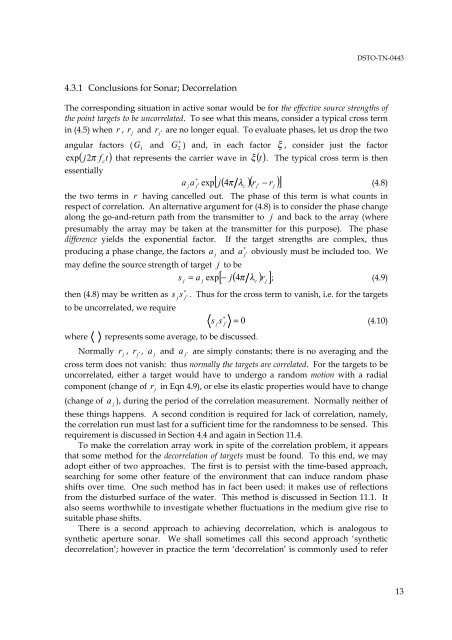Suitability of Correlation Arrays and Superresolution for Minehunting ...
Suitability of Correlation Arrays and Superresolution for Minehunting ...
Suitability of Correlation Arrays and Superresolution for Minehunting ...
Create successful ePaper yourself
Turn your PDF publications into a flip-book with our unique Google optimized e-Paper software.
DSTO-TN-0443<br />
4.3.1 Conclusions <strong>for</strong> Sonar; Decorrelation<br />
The corresponding situation in active sonar would be <strong>for</strong> the effective source strengths <strong>of</strong><br />
the point targets to be uncorrelated. To see what this means, consider a typical cross term<br />
in (4.5) when r , r<br />
j<br />
<strong>and</strong> r<br />
j ′ are no longer equal. To evaluate phases, let us drop the two<br />
angular factors ( G<br />
1<br />
<strong>and</strong> G ∗ 2<br />
) <strong>and</strong>, in each factor ξ , consider just the factor<br />
exp ( j2π<br />
f<br />
ct)<br />
that represents the carrier wave in ξ () t . The typical cross term is then<br />
essentially<br />
∗<br />
a<br />
ja<br />
j′ exp [ j( 4π λc<br />
)( rj<br />
′ − rj<br />
)]<br />
(4.8)<br />
the two terms in r having cancelled out. The phase <strong>of</strong> this term is what counts in<br />
respect <strong>of</strong> correlation. An alternative argument <strong>for</strong> (4.8) is to consider the phase change<br />
along the go-<strong>and</strong>-return path from the transmitter to j <strong>and</strong> back to the array (where<br />
presumably the array may be taken at the transmitter <strong>for</strong> this purpose). The phase<br />
difference yields the exponential factor. If the target strengths are complex, thus<br />
∗<br />
producing a phase change, the factors a<br />
j<br />
<strong>and</strong> a<br />
j′ obviously must be included too. We<br />
may define the source strength <strong>of</strong> target j to be<br />
s = a exp − j 4π λ r ; (4.9)<br />
j<br />
j<br />
[ ( c<br />
) j ]<br />
∗<br />
then (4.8) may be written as s s j j′ . Thus <strong>for</strong> the cross term to vanish, i.e. <strong>for</strong> the targets<br />
to be uncorrelated, we require<br />
s = 0<br />
(4.10)<br />
∗<br />
j s j′<br />
where represents some average, to be discussed.<br />
Normally r<br />
j<br />
, r<br />
j ′ , a<br />
j<br />
<strong>and</strong> a<br />
j ′ are simply constants; there is no averaging <strong>and</strong> the<br />
cross term does not vanish: thus normally the targets are correlated. For the targets to be<br />
uncorrelated, either a target would have to undergo a r<strong>and</strong>om motion with a radial<br />
component (change <strong>of</strong> r<br />
j<br />
in Eqn 4.9), or else its elastic properties would have to change<br />
(change <strong>of</strong> a<br />
j<br />
), during the period <strong>of</strong> the correlation measurement. Normally neither <strong>of</strong><br />
these things happens. A second condition is required <strong>for</strong> lack <strong>of</strong> correlation, namely,<br />
the correlation run must last <strong>for</strong> a sufficient time <strong>for</strong> the r<strong>and</strong>omness to be sensed. This<br />
requirement is discussed in Section 4.4 <strong>and</strong> again in Section 11.4.<br />
To make the correlation array work in spite <strong>of</strong> the correlation problem, it appears<br />
that some method <strong>for</strong> the decorrelation <strong>of</strong> targets must be found. To this end, we may<br />
adopt either <strong>of</strong> two approaches. The first is to persist with the time-based approach,<br />
searching <strong>for</strong> some other feature <strong>of</strong> the environment that can induce r<strong>and</strong>om phase<br />
shifts over time. One such method has in fact been used: it makes use <strong>of</strong> reflections<br />
from the disturbed surface <strong>of</strong> the water. This method is discussed in Section 11.1. It<br />
also seems worthwhile to investigate whether fluctuations in the medium give rise to<br />
suitable phase shifts.<br />
There is a second approach to achieving decorrelation, which is analogous to<br />
synthetic aperture sonar. We shall sometimes call this second approach ‘synthetic<br />
decorrelation’; however in practice the term ‘decorrelation’ is commonly used to refer<br />
13

















